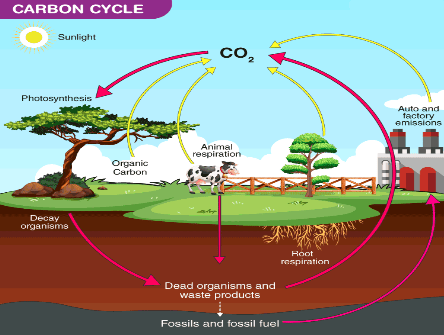The process by which carbon atoms are recycled by nature as they go from the atmosphere to various living things on Earth and then back into the atmosphere is referred to as the carbon cycle. The vast majority of carbon is stored in the world’s rocks and sediments, while the rest is dispersed across the world’s oceans, atmosphere, and living organisms.
Carbon Cycle Definition
The transfer of carbon compounds from one part of the earth’s environment to another, namely the biosphere, geosphere, pedosphere, hydrosphere, and atmosphere, is what’s known as the carbon cycle.
Carbon Cycle Steps
The following is a rundown of the major stages that make up the process of the carbon cycle:
- During the process of photosynthesis, plants take in carbon from the surrounding air.
- Animals consume these plants, which results in a buildup of carbon in their bodies as a bioaccumulate.
- When these plants and animals pass away, the process of decomposition causes carbon to be released back into the atmosphere.
- Any carbon that is stored underground rather than being returned to the atmosphere is eventually turned into fossil fuels.
- Subsequently, human activities make use of these fossil fuels, which results in the release of even more carbon into the atmosphere.
Carbon Cycle Diagram
The movement of carbon via a variety of routes is shown in the graphical representation of the carbon cycle that can be seen below.
The global carbon cycle is broken up into many different components, each of which serves as a storage for carbon and is connected to other components through a specific set of exchange routes. The main stages of the global carbon cycle are broken down into the following categories:
- The carbon that is present in the earth’s atmosphere in the form of carbon dioxide is known as the atmosphere.
- The Terrestrial Biosphere is carbon that has been incorporated into the surface of the earth, as well as carbon that has been incorporated into the surface of the earth by living species such as plants and animals.
- The Carbon Cycle in the Ocean Oceanic creatures, as well as inorganic carbon that is dissolved in the fluids, and carbon that is present at the surface of the ocean all store a certain amount of carbon.
- Geosphere: Excess carbon is stored as mineral and fossil fuel deposits a great distance below the surface of the planet in the geosphere. Limestone sediments store a significant amount of carbon inside their pores and crevices.
- There is also a significant amount of carbon that is sequestered inside the interior of the earth. Carbon may be found in high concentrations in both the mantle and the core of the planet. Volcanic activity is responsible for the release of carbon from the lower mantle into the atmosphere.

The Carbon Cycle in the Atmosphere of the Earth
Methane and carbon dioxide (CO2) are the two types of carbon that are found in the atmosphere of the planet in the greatest abundance (CH4). Both of these gases are considered greenhouse gases, which means they absorb and retain heat, which in turn warms the atmosphere.
Carbon Cycle on Land
The most prevalent form of carbon found in the atmosphere is known as carbon dioxide. Both natural and man-made activities, like the burning of fossil fuels, are responsible for the introduction of carbon dioxide into the atmosphere. Plants use a process called photosynthesis, in which they take in carbon dioxide in order to produce carbohydrates. The formula for the equation is as follows:
CO2 + H2O + energy –> (CH2O) n + O2
Oceanic Carbon Cycle
The ocean is considered a “carbon sink” because it takes in more carbon than it gives out. Calcium carbonate, which is produced when marine organisms convert carbon to it, is one of the primary components used in oysters and clams’ tough exoskeletons.
Importance of Carbon Cycle
Carbon dioxide, despite the fact that it is only present in trace levels in the atmosphere, serves a critical purpose in the maintenance of energy equilibrium and is responsible for the absorption of long-wave radiation from the sun. As a consequence of this, it serves the purpose of acting as a blanket over the Earth. The disruption of the carbon cycle may have significant consequences, including changes in climate and an increase in global temperature.
Key Points on Carbon Cycle
An essential component of living things is carbon. Carbon atoms are released into the atmosphere in the form of carbon dioxide when living things breathe. Green plants and other photosynthetic species take in carbon dioxide from the atmosphere and change it into organic molecules. These chemicals then go up the food chain.
Conclusion
The biogeochemical cycle of carbon is a complicated topic that has received a great deal of attention from scientists over the last three decades. The carbon cycle is noteworthy for a number of different reasons, one of which is that it has a considerable impact on the rate at which the greenhouse gas carbon dioxide contributes to an increase in average world temperature. Every single living creature on our earth needs carbon in order to function properly. Everything in our bodies, from proteins and lipids to our DNA, has a function to do. In addition, carbon is the element that forms the basis of all known life on Earth. As a consequence of this, the carbon cycle, in addition to the nitrogen cycle and the oxygen cycle, is absolutely necessary for the continuation of life on Earth.
 Profile
Profile Settings
Settings Refer your friends
Refer your friends Sign out
Sign out













